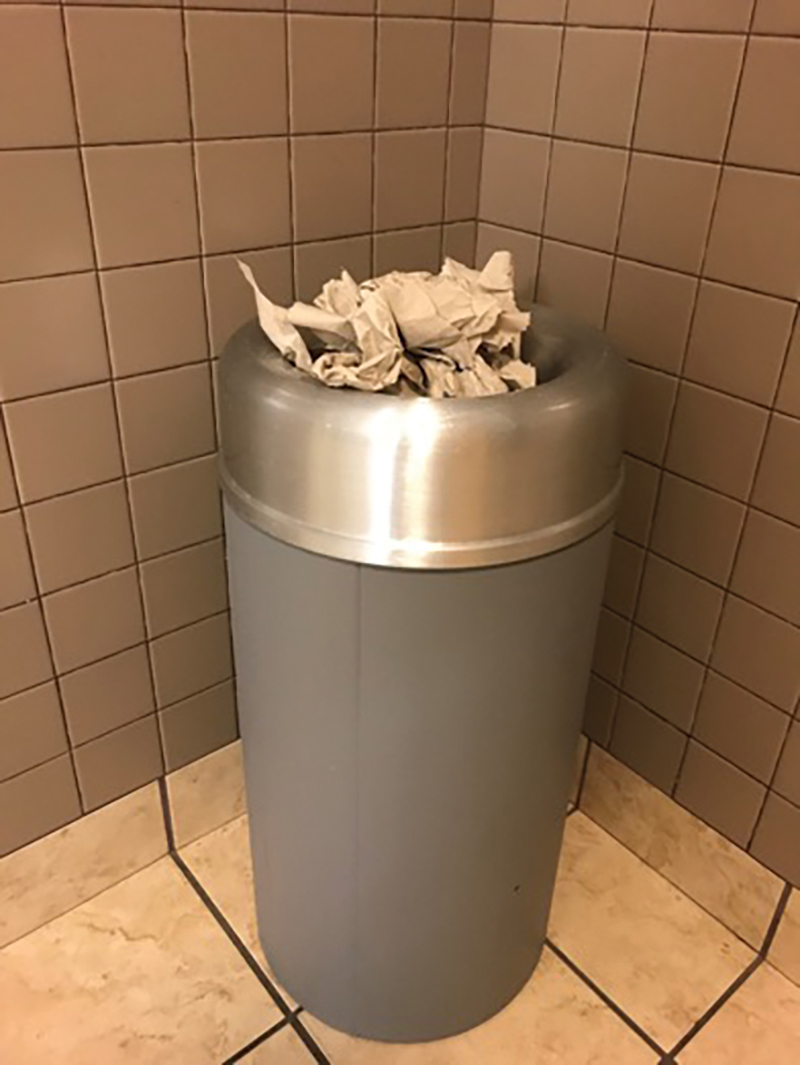feature
Designing Environmental Science Curriculum With PhotoVoice to Engage Nonscience Majors
Journal of College Science Teaching—May/June 2020 (Volume 49, Issue 5)
By Carolyn Waters and Kristin Cook
Increasingly urgent environmental issues require engagement efforts that include members of our communities who do not necessarily consider themselves to be environmentalists. One approach is to include environmental science courses as part of the general education curriculum at undergraduate institutions. Students who enroll in courses that meet a general education requirement may have differing attitudes about environmental issues based on their major or career choice. Students who are majoring in natural sciences may have more positive environmental attitudes than their nonmajor peers (Anderson et al., 2007). Photo-elicitation techniques, such as PhotoVoice, have been shown to support attitude changes and development of student engagement with topics that relate directly to students’ lives (Lintner, 2005; Madden & Dell’Angelo, 2016). PhotoVoice (Wang & Burris, 1994) specifically showcases individual stories as represented in photographs and conversations with knowledgeable community members. The example presented here showcases a curricular structure for enhancing engagement and deepening content knowledge through structured PhotoVoice assignments in an undergraduate environmental science course for nonscience majors.
PhotoVoice is one of many inquiry-based methods that increases opportunities for underrepresented populations to voice their concerns to the larger community. This participatory research method has been used to promote student engagement with course content and participation in the democratic process (Cook & Quigley, 2013). It gives importance to individual voice (hooks, 1994) and affords students the opportunity to think critically about local issues in ways that empower them to create positive change in their communities (Gruenewald, 2003). With the examples provided in this article, we hope to contribute to the growing body of knowledge related to the use of PhotoVoice in undergraduate science education (Cook & Quigley, 2013; Cook, 2014; Cook, Brown, & Ballard, 2016).
Using PhotoVoice in the curriculum
In the example to follow, undergraduate students at a private midwestern university photographed their communities to identify issues that were important to them. Over the course of one semester, they developed collective messages around the environmental themes their photographs depicted and shared them at an off-campus event with informed community members. The primary author was the professor for the course. The course fulfilled a lab science requirement for nonscience majors, meeting twice weekly for a lecture and once weekly for a lab for 14 weeks. Five assignments made up the framework for the semester-long PhotoVoice project (Table 1). A grading rubric for the assignments is provided in Table 2. Additional assignments for the course not discussed here included readings from an environmental science textbook, experiential lab activities, and exams. Below is a description of the curricular process and resultant themes of representation, inclusion, and democratic participation that arose in class discussions, activities, and assignments. Note to educator: Although this example discusses use of PhotoVoice assignments as a semester-long project, these assignments could be adapted and condensed into a shorter timeframe. Additionally, the utility of PhotoVoice is not limited to environmental science. PhotoVoice can be used to frame the curriculum for chemistry, biology, physics, or other science courses. Depending on the issue under study, students would be asked to look for real-life connections and photo document the issue in their surroundings.
| Table 1. Semester-long PhotoVoice curricular design. | ||||||||||||
|---|---|---|---|---|---|---|---|---|---|---|---|---|
|
| Table 2. Grading rubric for PhotoVoice assignments. | ||||||||||||||||||||||||||||||||||||
|---|---|---|---|---|---|---|---|---|---|---|---|---|---|---|---|---|---|---|---|---|---|---|---|---|---|---|---|---|---|---|---|---|---|---|---|---|
|
Creating personal connection with course content through photographs
As a way to dive deeper into course content, the first PhotoVoice assignment gave students an opportunity to develop inquiry questions they wished to explore in the context of the class. This assignment required students to photograph an issue of personal importance in the community where they live and to write a brief narrative using the following prompts (Cook, 2014; Wang and Burris, 1994).
- What is the issue?
- Why is this an issue?
- Why is this issue interesting or important?
- Who does this issue affect?
- Where is this issue occurring?
- What does the future look like for this issue?
- Develop three inquiry questions you might explore on the issue.
Figure 1 shows a student example of a photograph taken in the community. The student’s narrative indicated that she was interested in “various methods of transportation available and their effects on the environment.” Her inquiry questions were: “What acts/policies/programs does the United States have to promote environmentally friendly methods of transportation? What acts/policies/programs do other nations have to promote environmentally friendly methods of transportation? What methods of transportation have the most/least negative impact on the environment?”
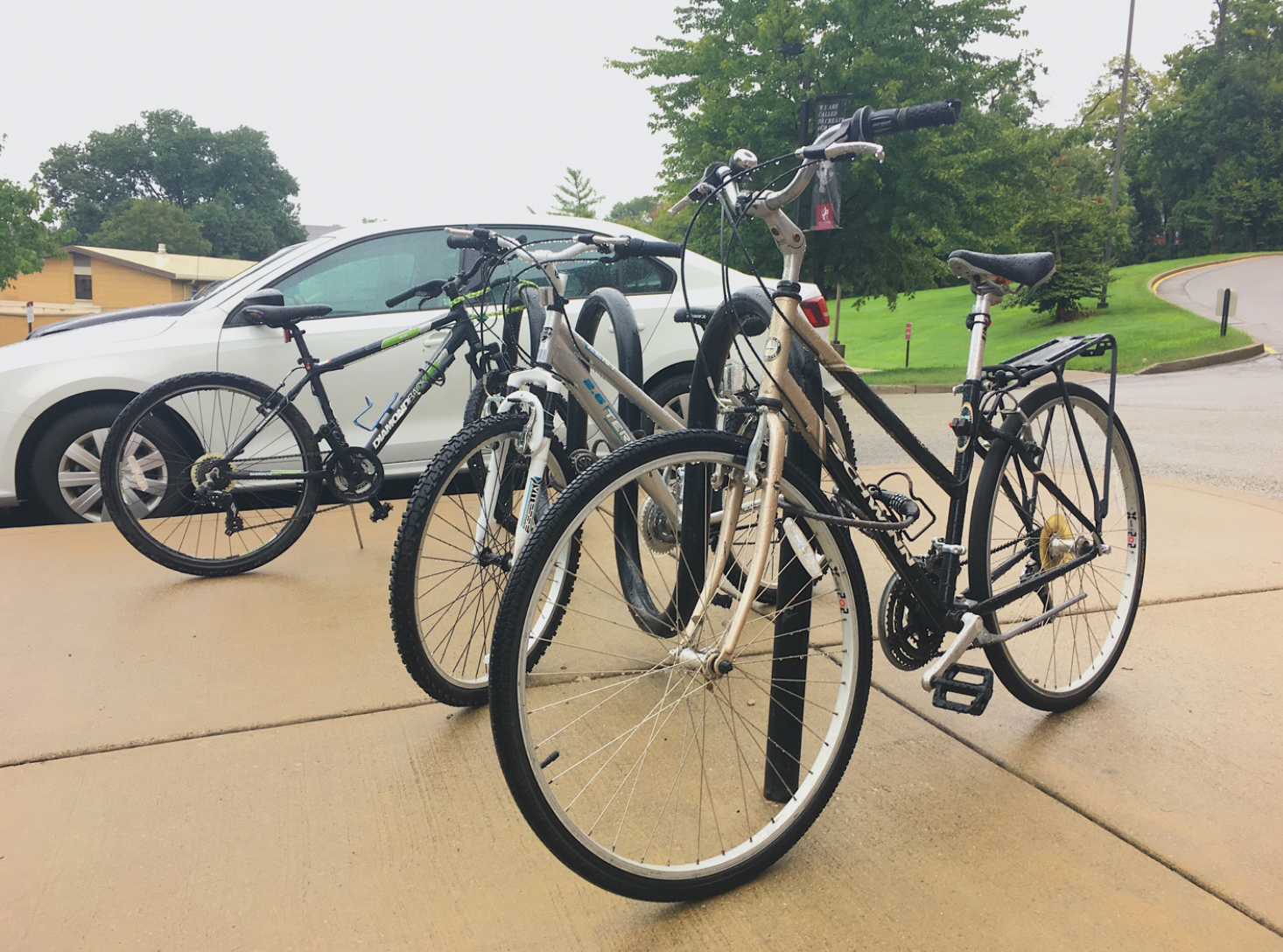
Example of a student photograph depicting bicycles on the university’s campus.
The photographs students took provided a way to connect their interests to course content and gave them a platform upon which to begin thinking about what they were interested in studying rather than the instructor telling students to focus on particular topics. Figure 2 provides an example from a student who photographed construction in her neighborhood to begin connecting with course topics of habitat destruction, urban development, and deforestation.
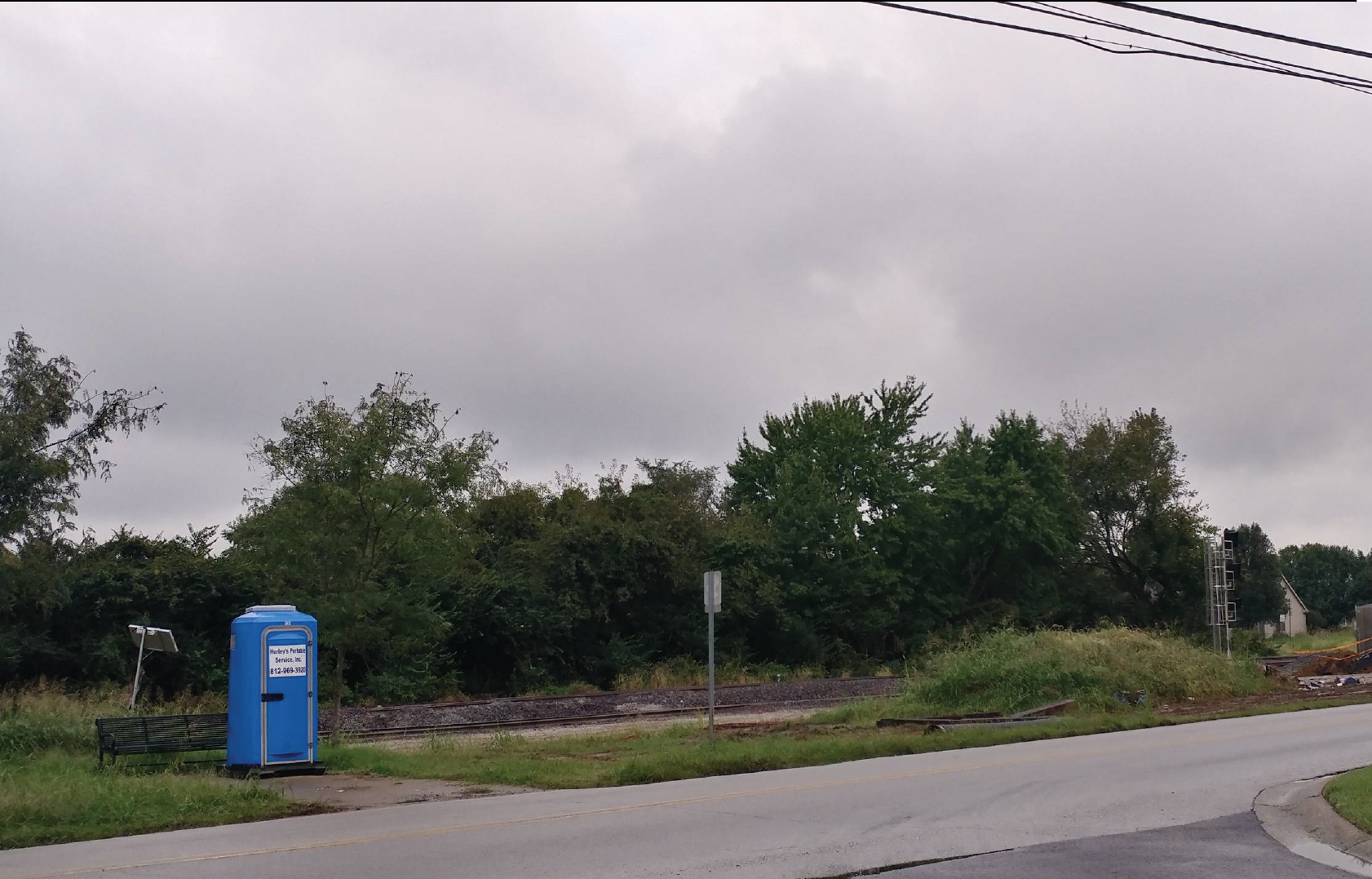
Student photograph and narrative excerpt.
“[My photograph] shows a view from the front entrance of my neighborhood. In this figure you can see there is construction going on. What you cannot see is all of the trees they cut down and bushes they tore down to put in a second railroad… When I saw them starting to wipe away these trees it made me very angry because there were animals living in this area that I loved looking at when I drove by. My Mom and I always looked for “our” ground hog every day… But now, he is nowhere to be found.”
As an introduction to this assignment, a local environmental photographer spoke to the class. He demonstrated smartphone photography techniques and examples of environmental issues with his photographs. He discussed photography ethics and consent required when including people in photographs. Note to educator: Common challenges students face in creating photos include wanting to use photographs made by other people or photographs that depict idealized places or issues. Students in this course were discouraged from making those choices and instead encouraged to focus on original photographs that depicted images from their daily lives. This restriction helped students make personal connections to environmental issues in subsequent assignments.
Classroom collaboration through theme generation
After students submitted the photograph and narrative assignment, they presented them aloud to the class. Students were asked to make note of the issues that their classmates mentioned in the narrative presentations. The instructors facilitated a class discussion of common themes from the presentations. Students worked in small groups to develop a collective statement that encompassed overarching, shared themes that students observed in their classmates’ photo narrative presentations. For example, one group of students understood the class message to be: “Everyone can play a part in bettering the Earth and environment, but individual involvement must be increased; and responsibility falls on the government to make laws and regulations, but environmental care is not enough of a priority in government.” This theme analysis brought up interesting thoughts about representation in democracy, both in the classroom and in the greater community. Note to educator: When providing feedback on student narratives, it is important to point out misconceptions students may express related to course topics. This can prompt students to focus their research to address those misconceptions with the next PhotoVoice assignment, the annotated bibliography.
Deepening content knowledge with annotated bibliographies
Once students had shared their narratives and photographs and conducted a collective analysis of themes, they were prompted to begin the annotated bibliography assignment. A campus librarian demonstrated research techniques and resources for bibliographic formatting. In a subsequent class meeting, students shared progress with a partner and practiced assessing sources for credibility (Blakeslee, 2004).
Students were required to summarize five sources related to their photo narrative topic. In addition, students had to synthesize the ideas the sources shared. One student summarized her findings in this way: “After examining the information in all of these articles, they have supported my original thought that paper towels are not the best for the environment, and that there are more environmentally friendly options to use instead. Until reading all of these sources, I was not even aware that paper towels could be composted. It makes sense that they would be as they often times have food remnants or other forms of dirt from cleaning up messes. Now that I know that paper towels can be composted, it seems like a good idea to try to reduce their impact on the planet if high efficiency air dryers can’t be used instead.”
As a result of synthesizing this information, this student, like others, revised her earlier inquiry questions to extend from a broad focus to more specific, targeted questions (Table 3). When providing feedback on this assignment, the instructor indicated which questions would be useful in conversation at the community event.
| Table 3. Student questions became more focused upon completing the annotated bibliography assignment. | ||||||
|---|---|---|---|---|---|---|
|
After completing these assignments, students reported increases in their knowledge (both in breadth and depth) and awareness of solutions related to their issue. Many found statistical information that reinforced previously acquired knowledge and expressed motivation to continue researching their topics. For example, one student stated, “I need to do more research on specifically how humans change the environment when clearing land. Maybe try to find an estimate of how many animals die from it in a specific area.” Note to educator: Practicing secondary research may be the most difficult part of this project for many students. In a class with students who have varying levels of experience with research, individualized instruction is often necessary.
Participation in a community event though PhotoVoice
As a culminating component to the PhotoVoice curriculum, students were required to attend a community event to discuss their photographs with informed community members. The professor partnered with a nonprofit organization that hosts a monthly event. This event brings together professionals who work in or have personal interest in environmental issues for a networking happy hour at a restaurant. The event sometimes features a speaker, or, in this case, students discussed their photographs and research. Attendees were asked to mingle and talk with students. In preparation for the event, a representative from the organization visited the class to explain what students could expect during the event.
Many students expressed anxiety about talking to professionals who may have deep knowledge about their PhotoVoice topics. To address these concerns, students practiced conversation skills in the classroom. The professor printed their photos on 8.5” × 11” card stock that students could hold for reference during conversations. Students practiced three different conversation scenarios: (1) basic conversation, including reminders of common cultural greetings such as making eye contact, shaking hands, and introducing themselves by first and last name; (2) difficult conversations, including scenarios such as “You are a CEO of a company that profits off of this issue and you are worried that the student’s proposed solution would reduce your profits.” and “You just want to talk about your own ideas. You are not interested in the topic.”; and (3) research-informed conversations in which students were guided to use notes and to “pause” the conversation so that they could refer to their research for details. Students appreciated reminders that conversation is a dialogue, not a presentation. They needed reassurance that they do not need to know answers to all potential questions and that they could also ask questions as part of the conversation.
Practicing for these conversations helped students build confidence in their knowledge and eased the tension when they arrived at the event. Discussing their PhotoVoice projects at the event—particularly with community members who are well-informed on these topics—forced students to make connections between their personal experiences and the research they had completed: “Since my picture included the package delivery company I work for, many conversations came up about better ways in which we can transport goods. I learned from one individual at [the event] that the transportation of goods and people by train is the most environmentally friendly way of transportation. Even though it takes more time than by plane, it is worth it because trains burn less CO2… Many people wanted to know what I would say to my company about this and that thought had never crossed my mind. One individual even asked me if my company talks about the amount of carbon emissions present in that area and I had to tell them no.”
This student drew connections between her job and course content as a result of talking to community members about her photograph. In addition, community members prompted her to take action toward solutions by talking to her supervisors or coworkers.
Speaking about their topics with informed community members helped students learn about existing solutions that they did not discover during their bibliography research. This led many students to feel more empowered to make positive changes through personal actions and increased their sense of hope about these serious and intimidating global issues. A student wrote: “I enjoyed the different points of views from each person in attendance. I found that the more people that you talked to the more variety of information and ideas you could come up with… I spoke with one lady that I connected quite well with about the topic of greenhouse gases and one of the solutions I had mentioned to her, she had already been taking part in, which made both of us happy to hear that the solution is a positive thing to be participating in.”
Knowing that other members of the community are actively involved in solving environmental problems gave students reassurance that positive changes are being made.
Student reflections on PhotoVoice
Following the community event, students were assigned a reflection paper that would be shared in class. This assignment asked students to write about how each component of the PhotoVoice project affected their learning. They were also asked to continue this line of thinking through the scientific process, specifically through drafting research questions and data collection methods.
During the class debrief session, student photographs were once again projected while they read their reflections aloud. In their reflections, many students were able to explain how the project components added to their knowledge: “Without the annotated bibliography I would not have gained the knowledge that I have now, and I would not have been able to even hold a conversation with anyone at the [community] event. This portion of the assignment is by far the most important because this is where students are actually expanding their knowledge on the subject of their interest.”
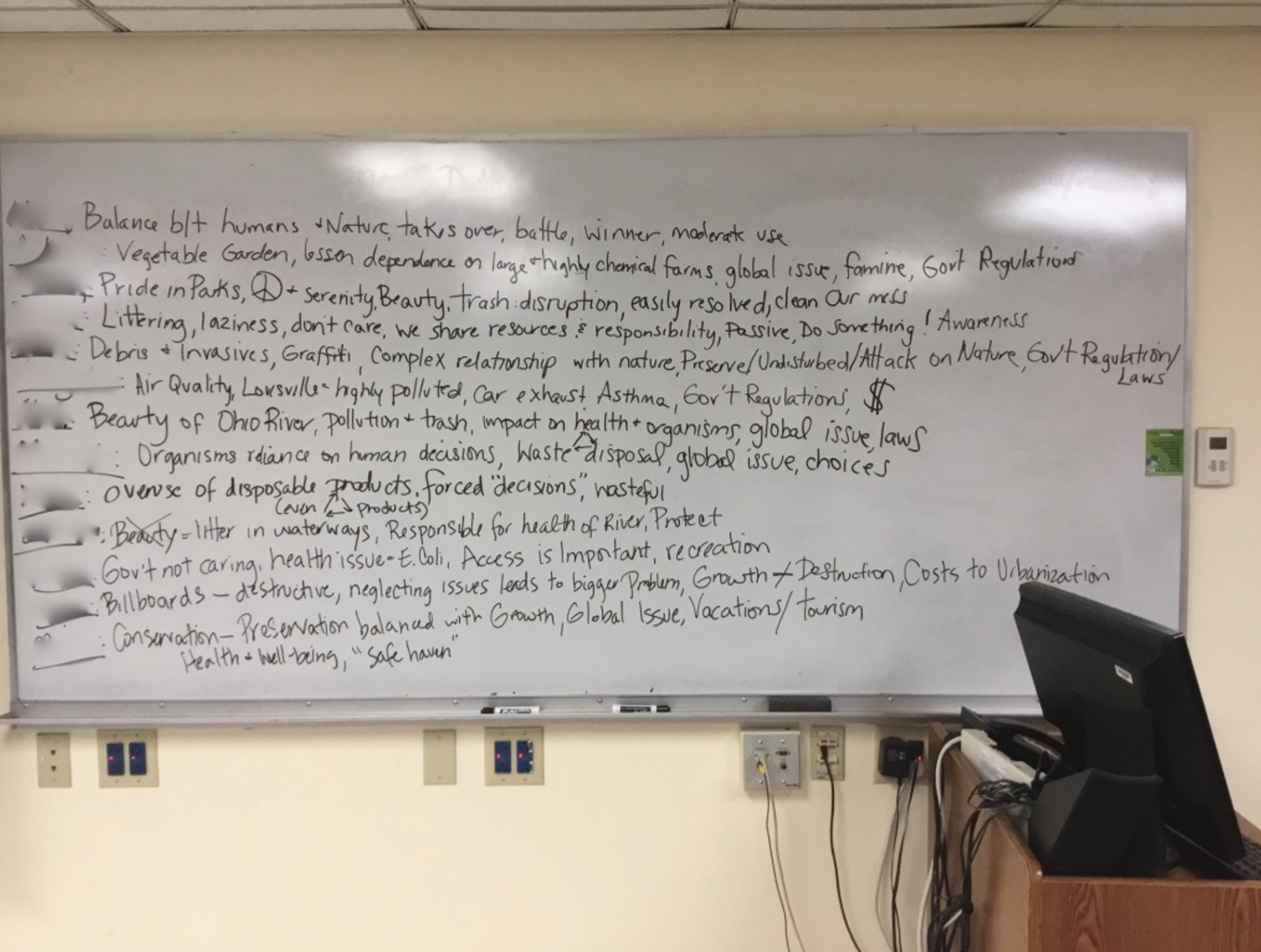
Group theme analysis of photo narratives.
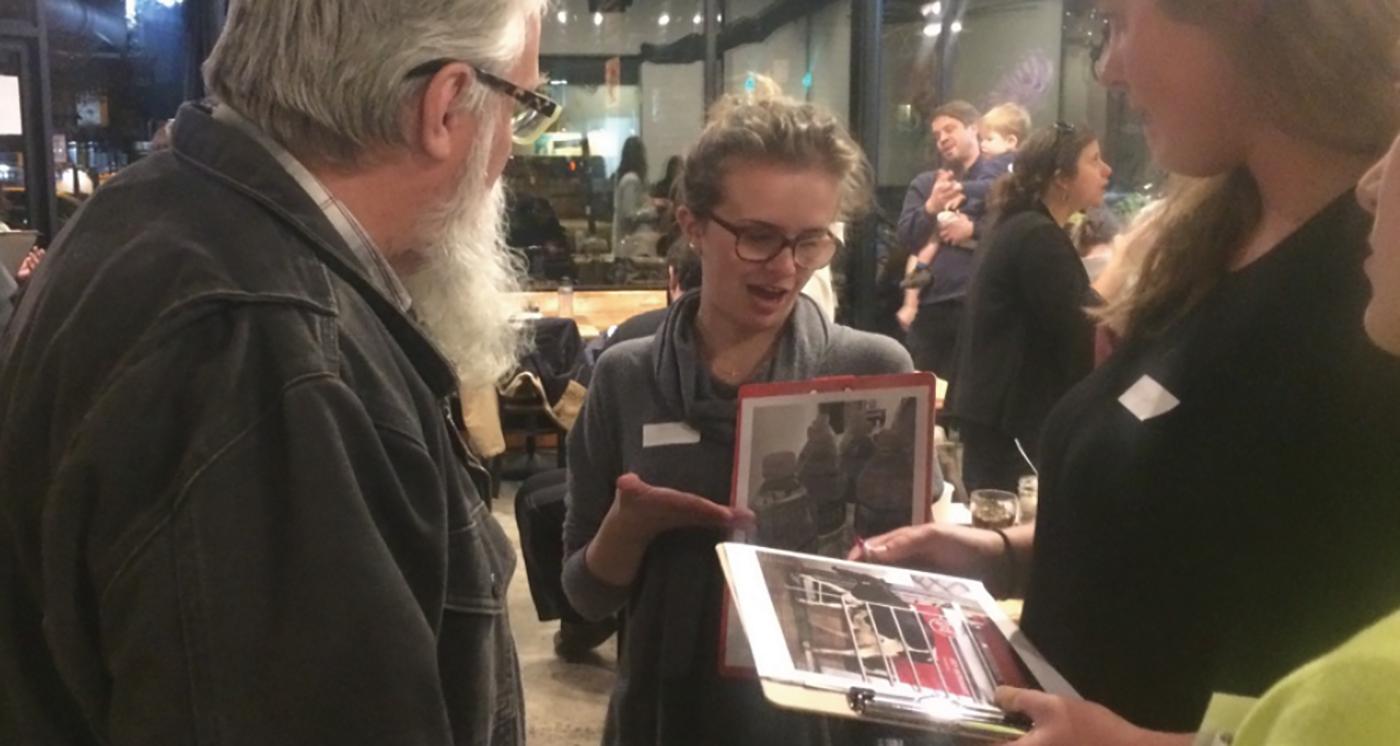
Students discuss their photographs and research with community members.
While some students identified the annotated bibliography as the most significant part of the project, others benefitted most from engaging in discussions at the community event: “Discussing the issue with other people really opened my mind up to different solutions… We talked about the political barriers that prevent certain legislative restrictions on deforestation in certain areas. We talked about it on a local level and a worldwide level. It made me think of all the possibilities of change by coming together, sharing our voices and opinions with one another, and putting our heads together to come up with new solutions.”
Other students had significant shifts in their worldview related to environmental issues because of the overall assignment structure, like this business major: “I thought that government should spend money on conserving the environment after they had fixed the other problems of society. But as I thought about this project more and more, my views on all of that started to shift… Often without a healthy environment, business will falter.”
Reported outcomes differed for each student, in part because of the individual nature of their topics, but also due to their various majors, year in school, and other personal experiences.
Note to educator: Organizing an event with community members can pose many challenges for both the instructor and students. Finding an existing, regular event alleviates some of the logistical stress for the instructor, but means that students will need to commit time outside of the scheduled class. By providing notice of this schedule change at the beginning of the semester, students can plan ahead for conflicts with other classes, jobs, or family obligations. For students who are unable to attend, a makeup assignment that meets the same objectives of dialogue with informed community members off campus can be given.
Discussion and implications
PhotoVoice as a frame to deepen content knowledge
In this environmental science class, the PhotoVoice project allowed for student-driven inquiry that helped students connect individual experiences to global issues while deepening their content knowledge. Prior to beginning the PhotoVoice project, students in this course privileged personal experience and had difficulty connecting that with existing research. By framing the assignment around individual narratives, students were positioned as experts on their perspectives. This also positions them as empowered learners who find intrinsic motivation to complete research and share their knowledge. However, some tension arises from the fact that students are not experts in the field of research that their topics relate to. Speaking with community members who are experts in those fields at an off-campus event provided balance to this tension.
Using the PhotoVoice project as a semester-long frame for curricular content placed the focus of the assignments on using content in reflection and interpersonal communication, rather than on memorizing content. At first glance, adding these assignments to an already full semester may seem overwhelming. However, it can lead to using course content as a medium to play with. The reflective and interpersonal skills were, for these nonscience major students, what made the content engaging and exciting.
The benefits of PhotoVoice curriculum are not limited to environmental science. By framing the assignments in a slightly different way, this structure could also help students to connect to issues in other scientific disciplines. For example, an engineering student could photograph structures in her neighborhood.
Inclusion and representation
A theme that emerged over the course of the semester was democratic representation and equity of voices (hooks, 1994). These issues came out as part of classroom discussions, activities, and in the PhotoVoice assignments. Student roles in campus life, the greater community, and in the broader context of democratic participation were frequently addressed.
A focus on individual representation started on the first day of the course when each person was required to share their perspective in discussion and play a part in task completion. Guest speakers served as examples in the classroom for how people represent themselves in a community. Inclusion of all voices and representation of the self also became part of assignments as students shared their perspectives and research by presenting to classmates. Working collaboratively to craft common messages and complete lab assignments drew the connection between individual voice and collective voice. This led students to think about ways that people can practice working in groups outside of the classroom context (neighbors, coworkers, etc.).
Focus on representation in the classroom also helped students to find a platform where they could voice their ideas to the larger community. Events like the one that these students attended are often not inclusive of voices beyond the professional population. However, this collaboration made it possible not only for young people to comfortably attend and participate in the conversation, but also for attendees and students to bring their young children, parents, and grandparents into environmental dialogue.
Bridging the idea of representation in the classroom to representation in democracy can be a transformative experience. As educators, we can help students transition from being learners only to being contributing members of society. We can help to position our students as capable, motivated members of the community who have valuable ideas. Through this kind of education, responsible learners become responsible community members who take ownership of solutions to environmental issues, regardless of their choice in career path.
Carolyn Waters (cwaters@bellarmine.edu) is a doctoral student of education and social change and Kristin Cook (kcook@bellarmine.edu) is an associate professor of science education in the School of Education, both at Bellarmine University in Louisville, Kentucky.
Curriculum Environmental Science Postsecondary



